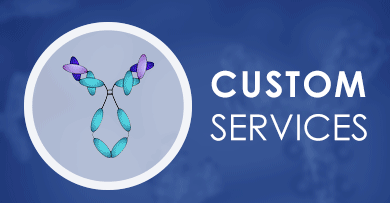+ Filter
 Loading...
Loading...

Cholera toxin
 Loading...
Loading...Anti-Cholera toxin Products
- Recombinant Anti-V. cholerae CT Antibody (MOB-246)
-
- Derivation: Mouse
- Species Reactivity: V. cholerae
- Type: IgG
- Application: WB, IF, FuncS
-
- Derivation: Mouse
- Species Reactivity: V. cholerae
- Type: IgG
- Application: ELISA, IP, FuncS
-
- Derivation: Human
- Species Reactivity: V. cholerae
- Type: IgG
- Application: ELISA, WB, IP, FuncS
-
- Derivation: Human
- Species Reactivity: V. cholerae
- Type: IgG
- Application: ELISA, WB, IF, FuncS
-
- Species Reactivity: Vibrio cholerae
- Application: ELISA
-
- Species Reactivity: Vibrio cholerae
- Application: ELISA, IHC, WB
-
- Species Reactivity: Vibrio cholerae
- Application: ELISA
-
- Species Reactivity: Vibrio cholerae
- Application: ELISA
-
- Species Reactivity: Vibrio cholerae
- Application: ELISA
- Mouse Anti-Cholera Toxin Antibody (clone YC003), mRNA (MRO-627-MZ-mRNA)
-
- Species Reactivity: Vibrio cholerae
- Rabbit Anti-Cholera Toxin Antibody, mRNA (MRO-629-MZ-mRNA) (MRO-629-MZ-mRNA)
-
- Species Reactivity: Vibrio cholerae
- Mouse Anti-Cholera Toxin Antibody (clone YC004), mRNA (MRO-630-MZ-mRNA)
-
- Species Reactivity: Vibrio cholerae
- Mouse Anti-Cholera Toxin Antibody (clone YC005), mRNA (MRO-645-MZ-mRNA)
-
- Species Reactivity: Vibrio cholerae
- Mouse Anti-Cholera Toxin Antibody (clone YC007), mRNA (MRO-648-MZ-mRNA)
-
- Species Reactivity: Vibrio cholerae
- Recombinant Human Anti-V. cholerae CT Antibody Fab Fragment (MHH-246-F(E))
-
- Derivation: Human
- Species Reactivity: V. cholerae
- Type: Fab
- Application: IP, IF, FuncS
- Recombinant Human Anti-V. cholerae CTX Antibody Fab Fragment (MHH-252-F(E))
-
- Derivation: Human
- Species Reactivity: V. cholerae
- Type: Fab
- Application: ELISA, IF, FuncS
-
- Species Reactivity: Cholera
- Type: Llama VHH
- Application: ELISA, IHC, FC, FuncS
- Recombinant Human Anti-V. cholerae CT Antibody scFv Fragment (MHH-246-S(P))
-
- Derivation: Human
- Species Reactivity: V. cholerae
- Type: scFv
- Application: ELISA, IF, FuncS
-
- Derivation: Human
- Species Reactivity: V. cholerae
- Type: scFv
- Application: FC, RIA, Biosensors, FuncS
- Recombinant Anti-V. cholerae CTX Antibody Fab Fragment (MOB-252-F(E))
-
- Derivation: Mouse
- Species Reactivity: V. cholerae
- Type: Fab
- Application: WB, ELISA, FuncS
- Recombinant Anti-V. cholerae CTX Antibody scFv Fragment (MOB-252-S(P))
-
- Derivation: Mouse
- Species Reactivity: V. cholerae
- Type: scFv
- Application: ELISA, WB, FuncS
- Recombinant Anti-V. cholerae CT Antibody Fab Fragment (MOB-246-F(E))
-
- Derivation: Mouse
- Species Reactivity: V. cholerae
- Type: Fab
- Application: WB, Neut, FuncS
- Recombinant Anti-V. cholerae CT Antibody scFv Fragment (MOB-246-S(P))
-
- Derivation: Mouse
- Species Reactivity: V. cholerae
- Type: scFv
- Application: ELISA, WB, FuncS
View More Products
Can't find the products you're looking for? Try to filter in the left sidebar.Filter By Tag
More Infomation
Our customer service representatives are available 24 hours a day, from Monday to Sunday. Contact Us
For Research Use Only. Not For Clinical Use.
Background
Cholera toxin (also known as choleragen and sometimes abbreviated to CTX, Ctx or CT) is AB5 multimeric protein complex secreted by the bacterium Vibrio cholerae. CTX is responsible for the massive, watery diarrhea characteristic of cholera infection.

Cholera toxin (also known as choleragen and sometimes abbreviated to CTX, Ctx or CT) is protein complex secreted by the bacterium Vibrio cholerae. CTX is responsible for the massive, watery diarrhea characteristic of cholera infection.
Cholera toxin (sometimes abbreviated to CTX, Ctx, or CT) is a protein complex secreted by the bacterium Vibrio cholerae. CTX is responsible for the massive, watery diarrhea characteristic of cholera infection. The holotoxin (choleragen) consists of a pentameric ring of B subunits whose central pore is occupied by the A subunit. The A subunit contains two chains, A1 and A2, linked by a disulfide bridge. The B subunit pentameric ring directs the A subunit to its target by binding to the GM1 gangliosides present on the surface of the intestinal epithelial cells. It can bind five GM1 gangliosides. It has no toxic activity by itself. After binding to gangliosides GM1 in lipid rafts, through the subunit B pentamer, the holotoxin and the gangliosides are internalized. The holotoxin remains bound to GM1 until arrival in the ER. The A subunit has previously been cleaved in the intestinal lumen but the A1 and A2 chains have remained associated. In the ER, the A subunit disulfide bridge is reduced, the A1 chain is unfolded by the PDI and disassembled from the rest of the toxin. Then, the membrane-associated ER oxidase ERO1 oxidizes PDI, which releases the unfolded A1 chain. The next step is the retrotranslocation of A1 into the cytosol. This might be mediated by the protein-conducting pore SEC61. Upon arrival in the cytosol, A1 refolds and avoids proteasome degradation. In one way or another, A1 finally reaches its target and induces toxicity.

